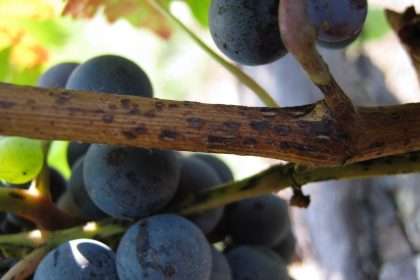I’ve been in and out of my office with my leaf roll survey project, and it has been bit difficult to frequently update the blog. Also, at this point, not much you can do about major fungal diseases. The critical time of infection is gone. If you see downy, powdery, or black rot on your bunches, the infection probably took weeks ago, if it was not a month. Thus, I will point some key issues at this time of the year.
Botrytis, downy, and other rot
We had a long period of wet and cool nights during the last half of August. This conditions favors both Botrytis and Downy mildew sporulation, and potential infection on nearby leaves. (i.e., it won’t spready quicky, but it probably enough to increase number of spores.) If it is followed by rain (like we had last week), the risks of Botrytis and downy mildew increase. As I mentioned earlier, downy mildew won’t touch berries at this point. Berries are resistant to the infection. However, with a prolonged rain or high humidity event, Botrytis can penetrate tissues to cause infection.
As I mentioned in last week’s viticulture note, it is good idea to protect your berries with Captan or Captan + Botytis material (Vangard, Elevate, etc), especially when you are expecting rain. Unfortunately, we do not have any curative materials against Botrytis, unless you apply materials within 24 hours, which is not a realistic number. Also, once sugar level go above 20 Brix, nothing much we can do in terms of management.
Downy and Powdery mildews
At this point, your berries are resistant to infection of downy and powdery mildew fungi, thus, your focus will shift to foliage management for both sugar accumulation to berries for harvest and to trunks for winter survival. Typically, foliage is easier to manage than fruit zone and you can extend your spray schedule to 10-14 day interval, especially you do not receive much rain.

Leaf roll survey
As I mentioned earlier, I’m conducting a survey for leaf roll virus (pictured above). Idea here is to have a better picture of leaf roll infestation in the state of Virginia, and also, by monitoring several years, I’d like to know how well it can spread within a vineyard. It is a free diagnostic opportunity for you (funded by the VWB), and there are spots available as of today. If you have any suspicious vines, please let me know so that I can arrange a visit to your vineyards. Other organism that I’m interested in is mealybugs (pictured below). Mealybugs can serve as a vector of leaf roll (virus). As you see in the picture, the bug is very tiny, but you can see them with naked eyes. If you have seen the bug, please let me know as well.



